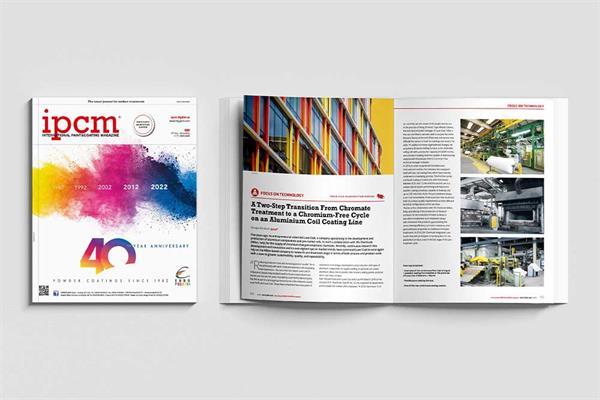
Read the latest issue of the magazine dedicated to surface treatments and organic and inorganic finishes.
As is well known, the aluminium surface finishing world is firmly dominated by powder coatings, not only in Europe but also in all markets “colonised” by European technology (let us not forget that the three market leaders in the design and construction of vertical systems for painting profiles are all Italian). North Africa, the Middle and Far East, but also Australia and New Zealand: cutting edge vertical and horizontal powder coating plants for aluminium profiles are springing up everywhere in these markets – ipcm® has often given proof of this with reports from companies in these geographical areas.
However, powder coatings for aluminium profiles and sheets still have to expand in one of the world’s largest markets: that of the United States, which is still strongly tied to solvent-based liquid coatings, due partly to its industrial heritage and partly to its still low environmental awareness level, resulting in sustainability not being seen as one of the main drivers of future development.
Currently, players in this market – you can read the success story of one of them, located in the Midwest, further in this issue – estimate that solvent-based paints still account for 60% of the aluminium finishing sector in the USA, but also that powder coatings will overtake very soon, supported by the technological innovations in plant engineering, application, and pre-treatment that you will find described in detail in this edition of ipcm®, which contains a special feature on architecture&design.
In general, however, growth forecasts for the powder coatings market have been positive for years now, and they will be no less so for the five-year period 2021-2026. According to the latest research report “Global Powder Coatings Market – Forecast to 2026” by Irish Research and Markets, it is expected to grow by 3.9%, with its total volume rising from USD 13.8 billion to USD 16.8 billion.
This is proof that powder coatings are increasingly penetrating the surface finishing industry. Not only are new market segments, such as components for agricultural machinery, earth-moving equipment, and off-road vehicles in general, increasingly opting for powders (in one or two-coat systems), but also sectors previously considered off-limits for these products are currently the subject of much R&D activity with encouraging industrial results. I am referring not only to MDF, but also to composite materials and certain plastics, heat-sensitive materials where the technological limits linked to the curing temperature required for melting and the subsequent hardening of the film can be overcome by developing low-temperature or UV-curable powders.
The increasing use of powders in the automotive sector will also create new and interesting opportunities for players in this market. Just think of the coating of batteries, motors, and energy storage units in electric vehicles, an application in which several powder manufacturers are now investing.
That said, whether organic or inorganic, each finishing technology has its own technical peculiarities and characteristics that are perfectly suited to one material rather than another, to one process rather than another, to one application field rather than another. True production sustainability is achieved not when one chooses the “greenest” technology on paper, but when companies opt for the most suitable solution to achieve maximum durability of their own products and to ensure environmentally friendliness even once it is integrated into their own industrial processes. Over the past twenty years, water-based coatings have made such great strides in terms of quality and durability that they have also conquered markets that used to be a prerogative of solvent-based paints, such as the corrosion protection one.
In any case, this growth dynamic between powder coatings and liquid and water-based coatings is certainly encouraging the technological advancement of the surface finishing industry.